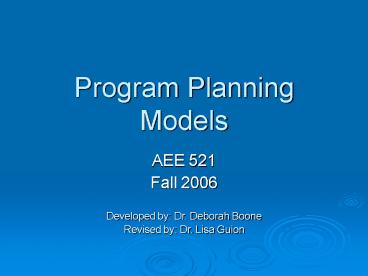Program Planning Models - PowerPoint PPT Presentation
1 / 19
Title:
Program Planning Models
Description:
Planning Models ... Some models are linear, in these, the planner is expected to start at step one ... proven best practices, empirically tested models, etc. ... – PowerPoint PPT presentation
Number of Views:1776
Avg rating:3.0/5.0
Title: Program Planning Models
1
Program Planning Models
- AEE 521
- Fall 2006
Developed by Dr. Deborah Boone Revised by Dr.
Lisa Guion
2
Planning Models
- Boone (1985) defines model as
- a representation of a particular situation, for
use in structuring an attack on new questions and
old questions that still need satisfactory
answers or solutions.
3
Planning Models
- Caffarella (1994) states that program planning
models consist of ideas about how programs should
be put together and what ingredients are
necessary to ensure successful outcomes.
4
Program Planning Models
- Program Planning models come in all shapes and
sizes. Planning models can be very simplistic
with steps 1-5 for example, or very complex,
using highly developed flow charts or in-depth
qualitative descriptions. - Some models are linear, in these, the planner is
expected to start at step one and follow each
step in order until the process is completed.
This may be helpful to newcomers, but soon loses
its appeal because it does not represent the day
to day working reality of most program planners.
5
Program Planning Models
- An alternative to the linear approach is to
conceptualize program planning as a process that
consists of a set of interacting and dynamic
elements or components. This non-sequential
model allows program planners to address a number
of the components simultaneously, to rearrange
components to suit the demands of different
situations. (Source Cafferella, 2002)
6
Usefulness of Planning Models
- Resources are used more efficiently
- Including people, time and money
- Daily work is made easier
- Provides a guide for continuing action
- Fosters teamwork
- Provides a means for clarifying
roles/responsibilities
7
Usefulness of Planning Models (Continued)
- More effective supervision and control
- Planner has a clear, detailed process outlined
- Development of better programs
- Models dictate proactive thinking
8
Why Models are not used
- Time Pressures
- Organizational Climate
- Lack of Knowledge About Models
- Belief That Models are Too Confining
9
Boones Conceptual Programming Model
- Consists of 3 interconnected and related
subprocesses 1) Planning, 2) Design and
Implementation and 3) Evaluation and
Accountability - Each subprocess includes sequenced and
action-driven processual tasks that should be
completed
10
Importance of Processual Tasks
- Unique to Boones Model
- Approach programming from a conceptual, process
oriented point of view RATHER THAN a trial and
error standpoint - Actions (tasks) are conceptually driven
- Actions (tasks) are logical and are well thought
out - Actions (tasks) based on theory, proven best
practices, empirically tested models, etc.
11
Subprocesses
- Planning
- The organization and its renewal process
- Linking the organization to its publics
- Design and implementation
- Designing the planned program
- Implementing the planned program
- Evaluation and Accountability
- Formative/process and summative evaluation
- Accountability
12
Boones Conceptual Programming Model
13
Planning
- Planning encompasses several processes that
influence the formation of a program - Plan program that help fulfill organizational
mission - Understand the culture, context, and structure of
the organization that the program will operate in - Commit to organizational renewal (using feedback
to improve organizational effectiveness and
relevancy)
14
Design and Implementation
- Determining needs
- Identification of target audiences
- Development of program objectives
- Setting program priorities
- Includes selection and/or development of
- Program content
- Delivery methods
- Resource materials
- Time line for implementation evaluation
- Conducting program
- Etc.
15
Evaluation
- Includes planning procedures to measure program
success (outcomes) and impact. - Determine how to measure short, midrange and
long-term change in target learners (what will
indicate that they learned) - OUTCOMES - Determine how to measure changes in societal,
economic or environmental conditions as a result
of the program IMPACTS - Determine how to measure any changes in policy
that may result - Report outcomes and impacts to key stakeholders
16
Using evaluation findings for
- program revisions
- organization renewal
- accounting to the publics, the organization,
funding sources, governance body - advance the profession (model program)
17
Some Guiding Principles for My Program Planning
Work Based on Boones Programming Model
- Must have commitment at all levels of the
organization. Must commit to organizational
renewal. - Study, analyze and prioritize target
publics/learners - Identify formal and informal leaders who will aid
in identifying and assessing specific needs of
target learners - Different types of needs, focus on felt and
expressed needs - Translating expressed needs into outcome-based
objectives then develop a planned program to
achieve objectives (planned change)
18
Discussion
- What are some general principles for planning
your community-based program(s) that you can take
from Boones Conceptual Programming Model?
19
References
- Boone, D. (2005). Course Materials from Program
Planning in Agricultural and Extension Education
offered Fall, 2005, at North Carolina State
University. - Boone, J. B. Safrit, R. D. and Jones, J.
(2002). Developing Programs in Adult Education
A conceptual Programming Model. Prospect
Heights, IL Waveland Press, Inc.































